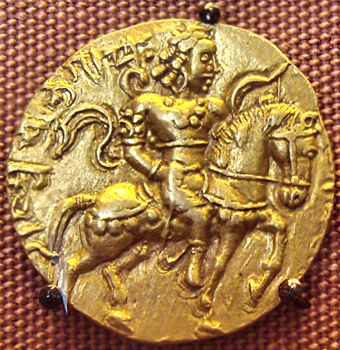 Chandragupta I, is described in his inscriptions as Maha Rajadhiraja that signifies a rise in the family wealth. It is surmised that the Gupta era began on the occasion of the coronation of Chandra Gupta I. The Guptas ruled over territories which included Prayag (Allahabad), Saket (Oudh) and Magadh (south Bihar). This description comes before the rule of Samudragupta and therefore must be referred to the territories ruled over by Chandragupta I.
Chandragupta I, is described in his inscriptions as Maha Rajadhiraja that signifies a rise in the family wealth. It is surmised that the Gupta era began on the occasion of the coronation of Chandra Gupta I. The Guptas ruled over territories which included Prayag (Allahabad), Saket (Oudh) and Magadh (south Bihar). This description comes before the rule of Samudragupta and therefore must be referred to the territories ruled over by Chandragupta I.
The gold coins issued by Chandra Gupta I honor his marital union with the Licchavi princess Kumari Devi. This strengthened the position of the Gupta dynasty and may have allowed a consequent expansion under Samudra Gupta. Records indicate that Chandragupta I reigned from 319-335 A.D. The Allahabad inscription seems to suggest that Chandragupta I had made a public announcement that Samudra Gupta would be his heir.
There are coins which indicate marital union of Chandragupta with Licchavi princess. Allan suggests that these coins were issued by Samudragupta to honor the marriage of his parents, while other scholars feel that Chandragupta issued them jointly with the Licchavis.
Samudragupta was proud that he was a Licchavi-dauhitra. The evidences infer that Samudragupta was grateful and indebted to the Licchavi people as the former helped him in some of his conquests. As Chandragupta I was given the title of Maha Rajadhiraja, it is clear that he was an independent ruler. Inscriptions show that the region possibly extending from Allahabad to River Ganga in the east formed the empire of Chandragupta I. He defeated the Magha kings of Kaulambi and Kosala and brought these territories under his own kingdom. It is said that Chandragupta I got Pataliputra in dowry from the Licchavis from where he laid the foundation of his empire and started conquering neighbouring states with the help of the Licchavis.
This article is a stub. You can enrich by adding more information to it. Send your Write Up to content@indianetzone.com



















